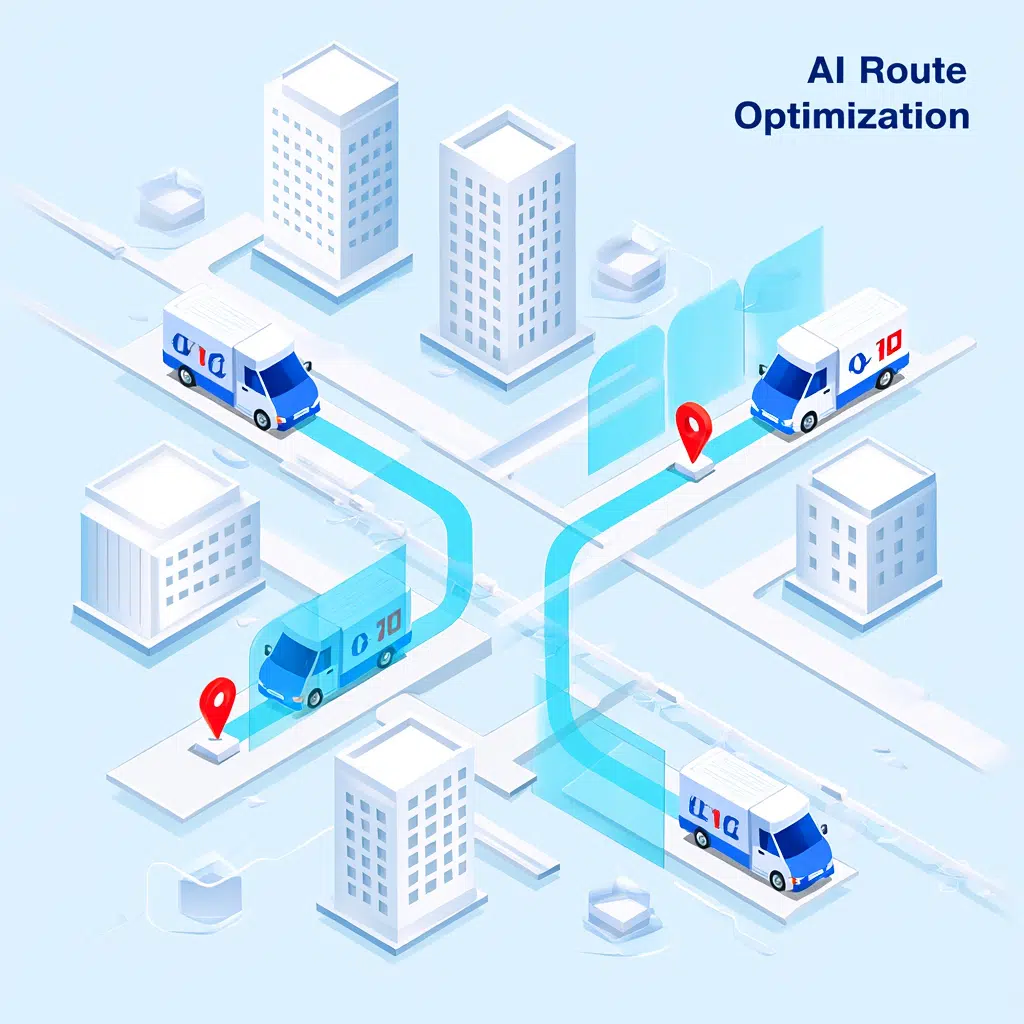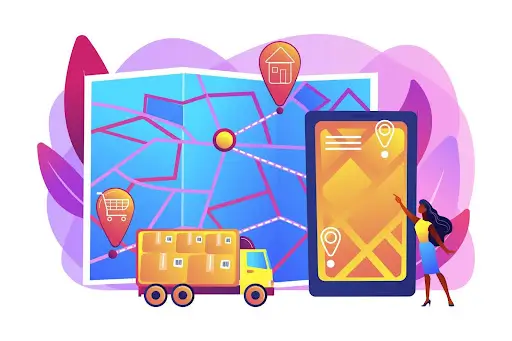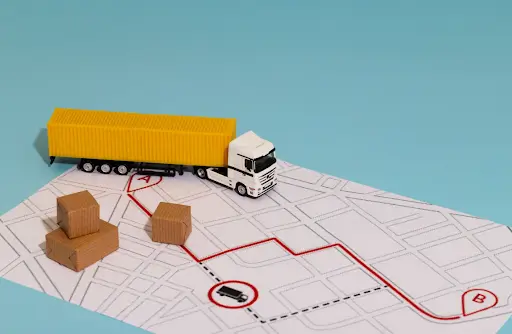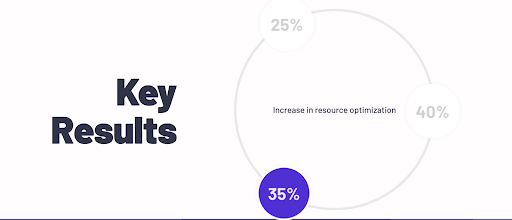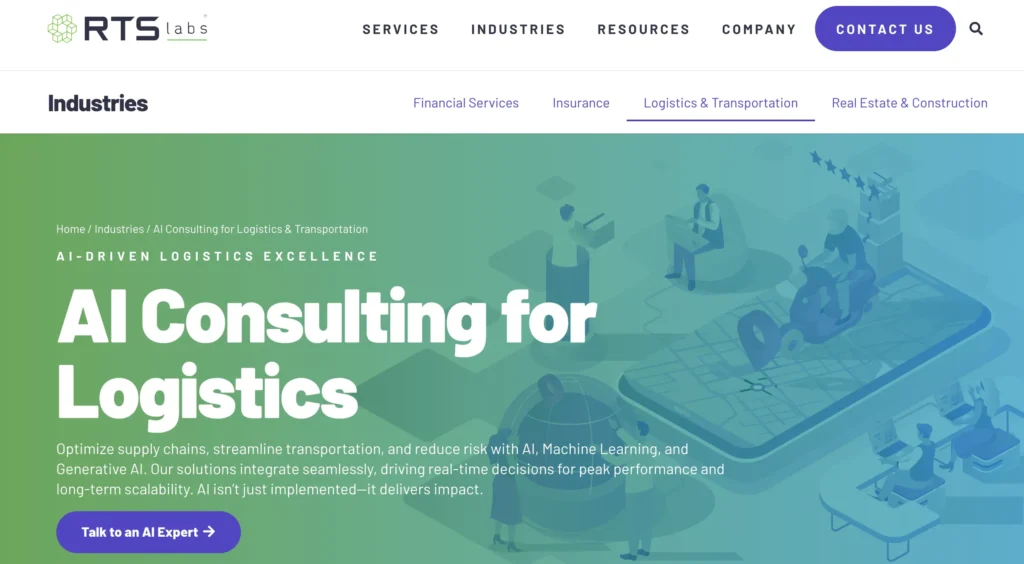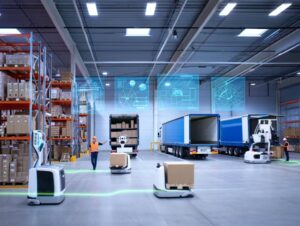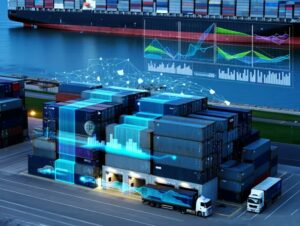In the U.S. Southeast in 2024, Hurricane Helene caused widespread flooding, damaging thousands of miles of roads and bridges, and disrupting the entire supply chain.
The storm resulted in reduced on-time truckload performance and the rerouting of shipments, significantly delaying emergency response efforts and the transportation of supplies.
Can we avoid large-scale supply chain disruptions?
Yes, with AI-powered route optimization, smarter logistics becomes possible even in crisis scenarios. AI can quickly adapt to these disruptions by identifying alternative routes, optimizing the flow of aid, and prioritizing the fastest paths for emergency services.
DHL is an excellent trendsetter in AI-driven route optimization. Since integrating AI into its Resilience360 platform in 2019, the company has achieved 90-95% accuracy in predicting the arrival time and destination of specific shipment volumes.
This article explains how AI route optimization works, the concrete benefits it provides, and how you can select the best approach to improve efficiency and scale your operations.
What Is AI Route Optimization?
AI-driven route planning updates delivery paths in real time by factoring in traffic delays, weather disruptions, roadblocks, and vehicle availability. As conditions change, the system recalculates routes without requiring manual adjustments, helping teams stay on schedule.
By reacting instantly to real-world constraints, AI helps logistics and transportation companies cut fuel waste, reduce delivery delays, and keep vehicles running at higher efficiency. These improvements lead to faster turnarounds, more efficient use of resources, and reduced operating costs in field services, freight, and last-mile delivery.
Key Components of AI Route Optimization in Delivery Networks
-
Predictive Modeling
AI examines historical delivery data to uncover patterns that often lead to delays, such as recurring traffic congestion near specific hubs or longer-than-average dwell times at certain locations. Factoring in variables like loading times, unloading durations, and stop-level dwell times allows the system to anticipate potential delays and refine routing decisions before disruptions occur.
-
Live Traffic Data
Using inputs from GPS devices, traffic APIs (e.g., Google Maps), and IoT-enabled sensors, AI systems access real-time updates on congestion, road closures, and accidents. When delays arise,due to construction, breakdowns, or other incidents, the software recalculates routes immediately to preserve delivery speed and minimize detours.
-
Geospatial Analysis
Route planning tools process topographical and spatial data to define service areas and calculate the most efficient paths. Elevation changes, road surface types, and physical barriers (like rivers or tunnels) are all factored in, especially important for deliveries in rural or hard-to-reach locations.
-
Constraint Optimization
AI aligns route plans with real-world limitations such as fleet capacity, time-window commitments, and legal driving hours. It ensures that each route respects these rules while still reducing total mileage and maximizing productivity. Regulatory mandates, like driver rest periods or load restrictions, are enforced automatically during route generation.
Suggested Read: Generative AI for Next-Gen Supply Chain Solutions
Rule-Based Routing Tools Vs. AI Route Optimization
When trying to understand traditional rule-based routing tools and AI-driven solutions, it’s important to understand the key differences in their capabilities.
| Feature | Rule-Based Tools | AI Route Optimization |
|---|---|---|
| Data Inputs | Static schedules, zip codes | Real-time traffic, predictive data |
| Flexibility | Limited | Highly adaptable to changes instantly |
| Optimization Scope | Basic shortest path | Multi-variable, dynamic constraints |
| Customization | Fixed logic | Tunable to business rules |
| Outcome | Rigid plans | Intelligent, evolving decisions |
This breakdown makes it clear: while rule-based tools rely on static inputs and fixed logic, AI-driven routing solutions offer dynamic optimization tailored to real-world conditions and evolving business needs.
How AI Route Optimization Works: A Practical Breakdown
Behind every efficient delivery route lies a network of real-time decisions shaped by data, constraints, and operational priorities. Let’s break down the core mechanisms at work.
Step 1: Data Ingestion
AI systems begin by collecting data from multiple sources that feed into the optimization process:
- Vehicle GPS and Telematics: Real-time data from GPS and vehicle sensors provides insights into location, speed, fuel levels, and refrigerated goods’ temperature. This data helps optimize routes for timely deliveries, and adjust for factors like fuel efficiency and traffic. The continuous monitoring of fuel levels helps plan timely refueling stops, while temperature monitoring safeguards sensitive goods, such as pharmaceuticals and perishables.
- Traffic APIs: Traffic data from services like Google Maps or TomTom is used to assess current road conditions and identify potential delays. This helps AI to avoid congested areas and suggest faster routes.
- Delivery Schedules: AI pulls data from Transport Management Systems (TMS) or ERP systems, which includes delivery windows, service level agreements (SLAs), and any special customer requirements. This data helps the system meet expectations such as on-time deliveries, adherence to SLAs, and fulfillment of specific customer needs like priority handling or special delivery instructions.
- Historical Delivery Logs: Past performance data is used to understand patterns and predict optimal routes. It takes into account average delivery times, traffic patterns, and historical delays during specific times of the day or year to find routes that minimize travel time, fuel consumption, and potential delays while ensuring timely deliveries.
Example: A retail logistics platform pulls historical delivery logs from previous peak seasons like Black Friday. It combines this data with live GPS data to adjust routes dynamically, improving delivery efficiency during high-demand periods.
Step 2: The AI Logic Behind Route Optimization
After data is ingested, AI systems apply specialized algorithms to calculate efficient, compliant, and cost-effective delivery routes.
- Clustering Algorithms
These algorithms segment deliveries by geographic proximity and service characteristics. Grouping stops located near each other reduces total mileage, cuts out detours, and improves fuel efficiency in both high-density urban areas and large-scale delivery runs. - Shortest Path Algorithms
Tools such as Dijkstra’s and A* identify the fastest and most practical connections between multiple delivery points. Rather than relying solely on distance, these models weigh variables like live traffic data, road conditions, and vehicle-specific constraints (e.g., axle weight limits or road restrictions), balancing speed with compliance and cost. - Constraint Solvers
AI applies constraint-solving techniques to enforce delivery windows, vehicle capacity, and driver availability. These solvers ensure each route adheres to regulatory requirements, such as maximum driving hours, and operational policies, while still optimizing resource utilization across the fleet.
Example: A field service company uses constraint solvers to manage technician schedules, ensuring that no technician exceeds the daily service hour limit while completing all scheduled tasks. This balances time efficiency and legal compliance.
Step 3: Real-Time Routing Decisions
After processing the data and applying model logic, the AI makes real-time routing decisions that directly affect operations:
- Dynamic Route Suggestions: AI systems continuously adjust routes in response to real-time factors, including traffic conditions, road closures, and weather disruptions. This ensures drivers always follow the fastest route, even if conditions change.
- Prioritization Logic: The AI sorts deliveries based on urgency, SLA requirements, or perishability of goods. For example, time-sensitive deliveries, such as medical supplies, are prioritized, followed by perishables and then standard deliveries.
- Incident Response: In case of incidents like vehicle breakdowns or unexpected traffic jams, AI reroutes deliveries instantly, minimizing delays and ensuring customers still receive their orders on time.
Example: A healthcare logistics provider reroutes a time-sensitive vaccine delivery in response to a sudden road closure, ensuring the vaccines arrive on time and remain at the correct temperature.
Operational KPIs Impacted:
- Cost-per-mile: AI reduces operational costs by optimizing routes to minimize mileage, improving fuel efficiency, and lowering fuel and maintenance expenses.
- Average Route Planning Time: AI automates the planning process, reducing time spent on manual planning.
- % of Successful First-Time Deliveries: Optimized routing increases the likelihood of successful first-time deliveries, enhancing efficiency.
According to McKinsey, embedding AI in operations reduces logistics costs by 5-20%, and inventory levels by 20-30%, demonstrating a profound impact on both financial outcomes and operational performance.
Catch RTS Labs Founder & CEO Jyot Singh on Ticker News as he breaks down how AI is transforming last-mile delivery and demand forecasting through sentiment analysis.
Watch the full video
Real-World Applications and Use Cases
Here are some industry-specific use cases where AI-driven routing delivers cost savings, efficiency, and enhanced customer satisfaction:
1. Retail Logistics: During peak seasons, such as Black Friday or the holiday rush, retail logistics teams must manage deliveries across multiple locations. AI route optimization allows businesses to adjust delivery routes in real time by analyzing factors like current inventory, live traffic conditions, and customer demand. This enables retailers to reduce delivery delays, cut fuel consumption, and increase overall fleet utilization, even during periods of high demand.
Our AI solutions help large enterprises and retailers operationalize intelligent routing, automating route planning, improving last-mile delivery accuracy, and maximizing fleet utilization during peak sales periods.
2. Field Service Management: Field service companies must deploy technicians based on job requirements, proximity, and the urgency of the task. AI-driven scheduling optimizes technician assignments by factoring in real-time location data, required skills for specific tasks, and service urgency. This reduces technician idle time, ensures the right technician is dispatched promptly, and minimizes response times.
Our custom AI-powered route optimization and forecasting systems integrate seamlessly with existing logistics and fleet management platforms, enabling smarter resource allocation and faster response times that directly improve service levels.
For example, our dynamic multivariate forecasting engine was embedded into a client’s infrastructure to deliver real-time, accurate revenue predictions. This enabled agile responses to market shifts, improving strategic decision-making and overall operational agility.
Result?
A 15% reduction in fuel costs and a 35% improvement in on-time arrivals, significantly boosting customer satisfaction
3. Healthcare Logistics: Delivering critical medical supplies, such as vaccines, requires precise routing to maintain the required temperature throughout transit. AI route optimization dynamically adjusts routes to prioritize the quickest yet compliant paths, ensuring both timely delivery and temperature integrity.
We also partner with healthcare logistics providers to build and implement AI systems that ensure timely, compliant deliveries, improving both operational efficiency and patient safety.
Is AI Worth the Investment?
The actual value of AI route optimization is realized when it is implemented according to your specific operational needs and business goals. The decision to implement AI should be based on specific operational needs and business goals:
When AI Route Optimization Makes Sense:
- High Delivery Volume or Time-Sensitive Routing: AI optimizes routes during peak seasons, prioritizing urgent shipments and ensuring on-time deliveries with maximum fleet efficiency. This enables businesses to manage high volumes while maintaining service quality and reducing delays.
- Operations Span Multiple Zones with Fluctuating Conditions: For businesses operating across diverse geographies, AI adapts routes in real-time based on varying traffic, road closures, and weather conditions.
- Manual Routing Causes Delays or Customer Churn: AI automates and optimizes the routing process, eliminating human error and reducing the time spent on planning and execution. Benefit? More efficient deliveries, preventing inefficiencies, missed deadlines, and customer dissatisfaction.
What to Measure:
- Cost Savings: Track reductions in fuel consumption, miles driven, and operational overhead.
- SLA Adherence: Ensure that deliveries meet agreed timelines, improving customer satisfaction and retention.
- Route Planning Time: Measure the reduction in time spent on manual tasks and the increase in operational speed achieved through automation.
Common Blockers:
- Data Availability: Without clean data from sources like GPS, traffic APIs, and delivery schedules, AI cannot operate at its full potential, which affects routing accuracy and performance.
- Legacy Systems: Legacy systems may not integrate effectively with AI tools, slowing down deployment and limiting scalability across your operations.
- Unclear ROI: To maximize ROI, businesses need clear KPIs, such as cost-per-mile, on-time delivery rate, and customer satisfaction, to track AI performance and demonstrate its value.
Build vs Buy: How to Choose the Right Approach
When evaluating route optimization solutions, you must weigh the benefits of pre-built against custom-built systems based on factors like scalability, flexibility, and integration needs. Here’s a breakdown of both approaches:
Pre-Built Tools:
Typically, off-the-shelf software is designed for standard logistics scenarios, such as fixed delivery schedules or single-channel distribution with trucks. However, it may not offer the flexibility that complex operations demand.
- Faster to Deploy: Pre-built solutions launch quickly, making them ideal for businesses with small-scale operations and smaller delivery radius.
- Basic Use Cases: These tools are well-suited for companies that don’t require advanced features or customized workflows.
- Limited Customization: Pre-built tools often lack the flexibility to tailor routing logic, integrate with existing systems, or scale as your business grows.
Custom-Built AI Solutions:
Custom-built solutions are designed to meet your specific business requirements, offering tailored features, real-time data integration, and the flexibility to scale without falling apart.
- Tailored to Business Rules: Custom solutions align with your operational workflows, business constraints (such as delivery time windows or fleet size), and KPIs, ensuring AI optimizes routes based on your specific needs.
- Integration with Legacy Systems: Custom solutions are built to integrate with your existing infrastructure, whether it’s ERP, CRM, or fleet management systems, ensuring seamless data flow for informed, timely actions across your operations.
- Scalable: As your business diversifies, custom-built systems smoothly adapt to increased delivery volumes, changing routes, and evolving business processes.
- Explainable and Transparent: Custom solutions provide full visibility into AI-driven decisions. You can adjust algorithms and parameters, gaining insights into how factors like traffic, weather, and fleet capacity influence route optimization, allowing for continuous refinement.
Evaluation Framework:
To decide whether a pre-built or custom-built solution is right for your business, consider the following:
- Are your routing needs specialized, like handling multi-stop deliveries, high-volume seasons, or last-minute changes? If your delivery operations involve frequent adjustments, a custom-built solution offers the flexibility to adapt.
- Do you need integration with internal logistics, ERP, or CRM tools? You need a custom-built solution for seamless integration, which will ensure data flows smoothly between systems and real-time insights are accessible across departments.
- Do off-the-shelf tools restrict model tuning or visibility? If customizing AI models or gaining clear insights into routing decisions impacts your business, you need custom-built solutions that offer greater control and flexibility.
How RTS Labs Helps Enterprises Build and Scale Customizable AI Route Optimization
Designed for complex logistics environments, our solutions go beyond generic tools by aligning with your specific operational needs, whether that means coordinating multi-modal transport, optimizing last-mile routes, or handling peak-volume scenarios with precision.
Our AI-driven route optimization minimizes fuel consumption, reduces delays, and enhances on-time delivery rates, all while seamlessly integrating with your existing ERP, TMS, and fleet management systems.
What We Offer:
At RTS Labs, we focus on creating AI route optimization solutions specifically designed to address the unique challenges of your logistics network.
- Discovery and Validation: We work closely with your team to understand operational challenges and identify where AI can deliver the most significant impact. This includes validating use cases and aligning AI-driven routing with specific business goals, such as improving route accuracy, reducing costs, and adapting to fluctuating demand.
- Custom Model Development: We develop custom ML models to address your unique logistics challenges. These include:
- Clustering: Grouping deliveries based on location and service type for efficient route planning.
- Constraint-Solving: Incorporating factors like delivery windows, fleet size, and operational rules into routing decisions.
- ETA Prediction: Using real-time data to forecast delivery times and adjust schedules.
- Systems Integration: We integrate AI solutions with your existing systems, such as ERP, TMS, and telematics, to facilitate real-time data exchange and minimize disruptions to your current operations.
For example, RTS Labs collaborated with Twiddy OBX to develop an “integrative technology” that seamlessly integrated with Twiddy’s existing platforms.
- Real-Time Capabilities: We provide AI solutions that handle real-time data such as traffic updates, vehicle statuses, and weather conditions. Our dashboards offer continuous insights into performance metrics like on-time delivery rates, fuel consumption, and fleet utilization.
- Ongoing Support: After deployment, we offer continuous monitoring, retraining, and change management to maintain system effectiveness and scalability. We track key performance metrics, adjust the model based on evolving business needs, and refine the AI to enhance accuracy and efficiency over time.
Achieve Operational Excellence with Custom AI Routing Systems
RTS Labs delivers AI route optimization solutions designed specifically for your logistics operations, addressing your unique challenges with precision. Unlike generic models, we work directly with your team to build custom systems that seamlessly integrate with your existing infrastructure.
Our solutions deliver measurable results, boosting operational efficiency, reducing costs, and driving long-term growth. With RTS Labs, you gain a trusted partner dedicated to transforming your logistics operations with actionable insights and sustainable improvements.
Ready to optimize your delivery network with AI?
Contact RTS Labs today to learn how you can effortlessly scale with our custom AI solutions.
FAQs
What type of data is required to implement AI route optimization?
Real-time vehicle GPS data, historical delivery logs, traffic feeds (via APIs), and operational parameters like delivery windows, fleet capacity, and service zones.
How does AI-based routing differ from rule-based systems?
AI systems dynamically adjust to real-world conditions, traffic, weather, and vehicle availability, while rule-based tools follow static logic with limited flexibility.
Can AI routing solutions integrate with our existing fleet management systems?
Yes. Our solutions are designed to integrate with leading telematics, GPS, ERP, and TMS platforms to ensure seamless data flow and minimal disruption.
What is the typical timeline for deploying a custom AI routing solution?
Production-ready systems are typically delivered within 60–90 days, including model development, integration, and validation.
Which industries see the greatest impact from AI route optimization?
Sectors with high delivery complexity, logistics, field services, retail, e-commerce, and healthcare, gain the most from dynamic, AI-driven routing.
